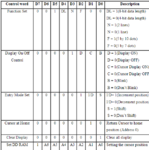knull
Newbie level 3

Hi newbie here, i have 2 questions.
1) How do i display a 2 digit No. on keypress?
2) When I press 5 on the keypad, the LCD displays '5'. How do i then store the value ive inputted?
I want to compare the number ive pressed to a randomly generated number.
this is my existing code
what works: i can display all single digit/characters on each key press but i cant display more than 1 digit on single keypress. keypad uses 74C922 encoder
 -> info on the lcd im using
-> info on the lcd im using
1) How do i display a 2 digit No. on keypress?
2) When I press 5 on the keypad, the LCD displays '5'. How do i then store the value ive inputted?
I want to compare the number ive pressed to a randomly generated number.
this is my existing code
what works: i can display all single digit/characters on each key press but i cant display more than 1 digit on single keypress. keypad uses 74C922 encoder
 -> info on the lcd im using
-> info on the lcd im using